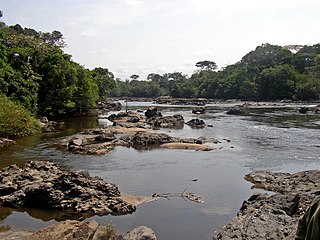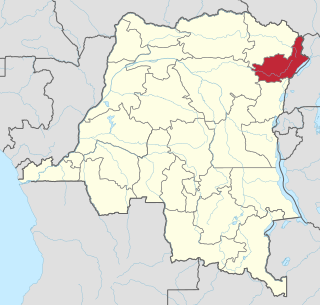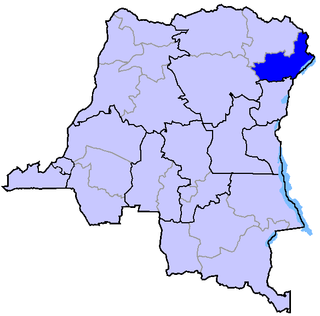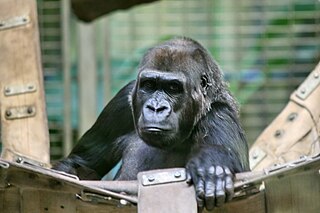
The okapi, also known as the forest giraffe, Congolese giraffe and zebra giraffe, is an artiodactyl mammal that is endemic to the northeast Democratic Republic of the Congo in central Africa. However, non-invasive genetic identification has suggested that a population has occurred south-west of the Congo River as well. It is the only species in the genus Okapia. Although the okapi has striped markings reminiscent of zebras, it is most closely related to the giraffe. The okapi and the giraffe are the only living members of the family Giraffidae.

The Ituri River is a river of the Democratic Republic of the Congo. It is the main tributary of the Aruwimi River, which forms where the Ituri meets the Nepoko River. It gives its name to Ituri Province.

The Okapi Wildlife Reserve is a wildlife reserve in the Ituri Forest in the north-east of the Democratic Republic of the Congo, near the borders with South Sudan and Uganda. At approximately 14,000 km2, it covers approximately one-fifth of the area of the forest. In 1996, the Okapi Wildlife Reserve was designated a UNESCO World Heritage Site, due to its large population of endangered okapis and its high overall biodiversity.

Virunga National Park is a national park in the Albertine Rift Valley in the eastern part of the Democratic Republic of the Congo. It was created in 1925. In elevation, it ranges from 680 m (2,230 ft) in the Semliki River valley to 5,109 m (16,762 ft) in the Rwenzori Mountains. From north to south it extends approximately 300 km (190 mi), largely along the international borders with Uganda and Rwanda in the east. It covers an area of 8,090 km2 (3,120 sq mi).

The Ituri Rainforest is a rainforest located in the Ituri Province of northeastern Democratic Republic of the Congo. The forest's name derives from the nearby Ituri River which flows through the rainforest, connecting firstly to the Aruwimi River and finally into the Congo.

Ituri Province is one of the 21 new provinces of the Democratic Republic of the Congo created in the 2015 repartitioning. Ituri, Bas-Uele, Haut-Uele, and Tshopo provinces are the result of the subdividing of the former Orientale province. Ituri was formed from the Ituri district whose town of Bunia was elevated to capital city of the new province.
The Nyungwe Forest is located in southwestern Rwanda, on the border with Burundi, where it is contiguous with the Kibira National Park to the south, and Lake Kivu and the Democratic Republic of the Congo to the west. The Nyungwe rainforest is probably the best preserved montane rainforest in Africa. It is located in the watershed between the basin of the river Congo to the west and the basin of the river Nile to the east. From the east side of the Nyungwe forest comes also one of the branches of the Nile sources.

The Wildlife Trust of India is an Indian nature conservation organisation.

The wildlife of the Democratic Republic of the Congo includes its flora and fauna, comprising a large biodiversity in rainforests, seasonally flooded forests and grasslands.
Corneille E.N. Ewango is a Congolese environmentalist, and was responsible for the Okapi Faunal Reserve's botany program in the Democratic Republic of Congo from 1996 to 2003. He was awarded the Goldman Environmental Prize in 2005 for his efforts to protect the Okapi Wildlife Reserve in the Ituri Rainforest during the Congo Civil War. The reserve is home to the Mbuti people, and houses animals such as okapis, elephants and 13 primate species. Ewango has uncovered 270 species of lianas and 600 tree species in the area.

The Ituri Interim Administration is an interim body that administers the Ituri region of the Democratic Republic of Congo (DRC). It was established in 2003 by the Ituri Pacification Commission and supported by the UN mission in the DRC.
An okapi is a giraffid artiodactyl mammal native to the Ituri Rainforest in central Africa.

The Central Congolian lowland forests are an ecoregion within the Democratic Republic of the Congo. This is a remote, inaccessible area of low-lying dense wet forest, undergrowth and swamp in the Cuvette Centrale region of the Congo Basin south of the arc of the River Congo.
iGorilla is a software application (app) that is designed for use with the internet and multimedia enabled smartphones iPhone or iPod Touch, which were created by Apple Inc. iGorilla is the first app to be dedicated to the protection of mountain gorillas and is evidence that organizations involved in wildlife conservation are using digital media technology to raise funds and awareness by communicating directly with people who are concerned about the planet’s biological heritage.

The wildlife of the Central African Republic is in the vast natural habitat in the Central African Republic (CAR) located between the Congo Basin's rain forests and large savannas, where the human density was smaller than 0.5 per km2 prior to 1850. The forest area of 22.755 million, considered one of the richest storehouses of wildlife spread over national parks, hunting reserves and community hunting areas, experienced an alarming loss of wildlife because of greed for ivory and bushmeat exploitation by hunters – mostly Arab slavers from across the borders of the Central African Republic with Chad and Sudan.
Wamba is a town in Haut-Uele province of the Democratic Republic of the Congo. It is the administrative center of Wamba territory.
Paul Sadala, alias "Morgan", was a Congolese militant, poacher and faction leader. Throughout the 2000s, Sadala grew into an elephant poaching kingpin in northeastern Congo, particularly in and around the Okapi Wildlife Reserve. He was arrested on at least two occasions by ICCN park rangers. In 2011, styled Morgan, he initiated the militant group "Mai Mai Lumumba" while it was commonly known as "Mai Mai Morgan". Morgan and his rebels were accused of committing the most severe crimes, such as cannibalism, rape, kidnapping and murder. Their most high-profile attacks included a siege of Epulu village, the headquarters of the Okapi Wildlife Reserve early on the morning of June 24, 2012. Morgan occupied Epulu until the afternoon of June 25, 2012 before vanishing back into the forest. In the wake of this attack, 7 people were killed, while the entire captive population of okapi in Epulu's breeding center were also shot and killed by the rebels. FARDC soldiers arrived and looted the village. Morgan enjoyed support from FARDC units in Bafwasende and Kisangani In January 2013, Morgan occupied the large town of Mambasa for several hours before finally being repelled by the Congolese army.
Lomami National Park is a national park located in the Democratic Republic of Congo in Central Africa. Situated within the middle basin of the Lomami River, it straddles the Provinces of Tshopo and Maniema with a slight overlap into the forests of the Tshuapa and Lualaba river basins. The National Park was formally declared on 7 July 2016. It is the 9th national park in the country and the first to be created since 1992.

The Northeastern Congolian lowland forests is a tropical moist broadleaf forest ecoregion that spans the Democratic Republic of the Congo and the Central African Republic.
Environmental issues in the Democratic Republic of the Congo are the consequence of compounding social and economic problems, including lack of access to clean energy, clearing of lands for agriculture and economic development, and armed conflict. Major environmental issues in DRC include deforestation, poaching, which threatens wildlife populations, water pollution and mining.











